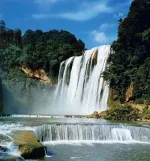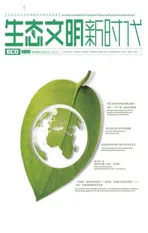一条瀑布:申遗路上的生态修复
2018-04-25徐荣锋
徐荣锋 贵州日报记者
今天,黄果树瀑布申请世界遗产名录的工作正在有条不紊地推进。但鲜有人知的是,早在 25年前,它就曾经提出过申请,但在最后一刻却主动撤回。
1992年6月,卢卡斯和桑切尔两位专家对黄果树的资源、环境进行了考察。考察结束,卢卡斯在临上飞机前说:“黄果树的风景资源在亚洲是最有影响的。”在场的人无不欢欣鼓舞,认为黄果树胜券在握。但让人始料不及的是,专家在离开贵州后却提出“暂缓提交”的建议,理由是,人工痕迹太重,生态环境太差。
按照“世界遗产”申报规定,一处景区只能申报一次,若被否决,便永远不能再申报。因此,在联合国教科文组织召开会议讨论表决前,国家建设部明智地将黄果树景区的申报材料撤回。
事后有专家总结,黄果树落选原因有四:一是半边街村寨人口太多、太密;二是部分违章建筑破坏了原有的地形地貌,人为痕迹和城市化现象严重;三是生态环境和植被覆盖较差,景区的森林覆盖率只有7.2%;四是上游水土流失和污染较为严重。
针对这些意见,贵州省提出,加大景区绿化和黄果树“半边街”的搬迁工作,力争10年后再次申报。
实际上,黄果树存在问题远不止专家提出的那些,而再次申报的路也远不如想象的好走。
黄果树景区一直没有垃圾处理厂,垃圾均运到低洼处堆放,不久便堆积如山,极大地污染了环境;景区所有宾馆、招待所、旅店、餐馆都没有专门的污水处理设施,污水未经处理就直接排入白水河;上游的一些企业和小煤窑污染河道,景区水质污染逐渐加剧。有专家预言,若不下大力进行生态重建,50年后黄果树作为风景名胜将不复存在。
为了彻底解决好上述一系列问题,还公众一个绚丽多姿的黄果树,1999年4月,贵州省政府决定成立黄果树风景名胜区管理委员会,并赋予其相应的管理职能,对景区内的资源保护、开发、建设、经营和地域经济社会发展实行统一领导和管理。
黄果树管委会成立一年,就大力抓景区的外围绿化、25度以上坡地的退耕还林及黄果树新城的规划工作,仅2000年就完成景区内11700亩的退耕还林,这是黄果树景区开发20年来绿化面积最大的一年。
2006年,“半边街”的搬迁工作启动。搬迁历时近 7年,投入近10亿元,2013年9月3日下午,最后一户住户完成搬迁。随后,投资5000万元的“半边街生态覆绿”工程启动,约半年后,昔日杂乱无章的“半边街”摇身一变成了“生态长廊”。

回望黄果树景区的生态治理之路,走得慢,走得艰难,也走得稳健。
一位工作人员说,黄果树景区属于典型的喀斯特地貌,土层平均厚度不到20厘米,宜林荒山荒地海拔高、水分蒸发快、气候干旱,大部分都是石漠化特别严重的地区,施工强度特别大。由于土层硬,十字镐、钢钎、锄头等工具轮番上阵也很容易损坏,几乎每天都要更换新工具 ;挖坑时,挖出来的是一层又一层的砂石,无法养活树木,施工队伍只能一筐一筐地从山底背新土回填,路途遥远,坡度又陡,有些地方一个人一天只能背三趟;要用水浇苗,只有采取人挑马驮的方式,一桶桶送上去……
黄果树景区的森林覆盖率就这样艰难而显著地提升,1999年提高到30.35%,2011年达到50%以上;2017年达到56%,特别值得一提的是,核心景区森林覆盖率达到 79% 以上,比当年的 7.2%增长了十倍多。2015年,黄果树瀑布荣获由联合国环境规划署颁发的“全球低碳生态景区”荣誉证书及奖杯,成为旅游区生态建设典范。
绿,一年年,一点点,攒起来了,但这些数据和荣誉的背后,是黄果树人 20多年来令人无法想象的艰辛付出。经过生态治理,大家的底气更足了,相关部门表示,黄果树景区将力争用三四年的时间列入世界自然遗产名录。
One Waterfall:Eco-rehabilitation on the Road of Cultural Heritage Application
Xu Rongfeng Guizhou Daily Reporter
Today, the work of the Huangguoshu Waterfall’s application for cultural heritage is ongoing progressively. But few people know that as early as 25 years ago the application work has already been done only to be withdrawn by the applicant at the very last minute.
In June, 1992, two experts, Lucas and Sanchel, examined the Huangguoshu Waterfall about its natural resources and environment, and before boarding the plane after completing the survey, Lucas said,“the scenic resource of the Huangguoshu Waterfall is the most influential in Asia.” Everyone on the spot was exhilarated about it and believed that the Huangguoshu Waterfall would surely succeed in the application. However, when the experts left Guizhou,they proposed “application suspended” in the reason of “overly man-worked and poorly eco-maintained”.
According to the requirements of application for World Heritage Site, one scenic area can only apply once, and any failure in the application implies no further application is valid. Therefore, before the UNESCO began its discussion and voting, the former Ministry of Construction of China wisely withdrew all the application materials.
Then, some experts summarized that the Huangguoshu Waterfall failed for four reasons: 1. The population of Banbianjie Village was too much and too dense, 2. Some illegal constructions sabotaged the original landscapes and presented too much urbanization and man work, 3. Bad ecology environment and poor vegetation coverage which was merely 7.2%, 4. Severe water and soil loss problem on the upstream area.
Following these suggestions, Guizhou proposed relocation of Banbianjie Village and aim for a successful re-application 10 years later.
But the reality was, what the Huangguoshu Waterfall lacked was far more than what those experts spotted, and re-application was far harder a road to walk on than what was imagined.
The Huangguoshu Waterfall possessed no waste disposal plant. Garbage was transported to low areas and accumulated, polluting the environment massively; all service business in the area hotels, hostels, motels, and restaurants had no sewage treatment, waste water went straight in White Water River; some enterprises and small coal pits polluted the river as well bringing more severity to the already worse situation. Some professor predicted that if no hard work of redemption was done 50 years later there will be no fantastic Huangguoshu anymore.
In order to solve all the problems as said and return the public a magnificent Huangguoshu, Guizhou set up Huangguoshu Scenic Management Committee and vested it with corresponding supervison power to lead and manage the area’s resource protection, development, construction, operation and area economic-social development work.
After one-year’s establishment, the Huangguoshu Committee strongly dealt with peripheral greening, grain for green on 25°slope and above, and new Huangguoshu city planning. The result was grain for green 11700 mu only by the year 2000, being the greatest green area in 20 years.
On the other Banbianjie Village started relocation in 2006. 7 years of work and 1 billion investment paid off for that in the afternoon of September 3rd, 2013 when the last household finished its relocation. And it was more than that, 50 million of Banbianjie re-green work kicked off and by only half of the year messy “one-side street” turned into an “eco gallery”.
Looking back on Huangguoshu’s eco rehabilitation road, it was a long one, a hard one, and yet it was also a firm one, a right one.
One staff told us, because the Huangguoshu scenic area is a typical karst landscape, with average soil thickness less than 20 centimeter, plus all the available mountains and lands suitable for afforestation are on high altitude. Dry weather and rapid moisture losing made most of the lands severe rock desertification. It was hard for construction. Rigid soil layer broke tons of picks, chisels, and hoes; everyday, a new batch of tools were needed. When they dug pits for planting, only sand and rocks were found so the construction team carried fresh soil on their back all the way from the foot of the mountain, however long and rugged way left some places three rounds per person tops. And as to watering,man shoulders and horse backs were the only way to deliver clean water.
Hence the forest coverage climbed difficultly and dramatically: up to 30.35%in 1999, over 50% in 2011, and 56% in 2017. What is more, forest coverage in core scenic area achieved more than 79%, which is eleven times more than what was 7.2% when everything first started. As a result, in the year 2015, the Huangguoshu Waterfall was awarded the honor of “World’s Low Carbon Ecological Attraction”and became a model for ecological construction in tourist area.
Year by year and bit by bit, green adds up in Huangguoshu. But behind all the glory and applause is 20 years of unimaginable contribution from Huangguoshu people. And the morale is high, according to the authority, now the ecological rehabilitation is completed, Huangguoshu will try to win the laurel of World Natural Heritage in about 3 to 4 years.
